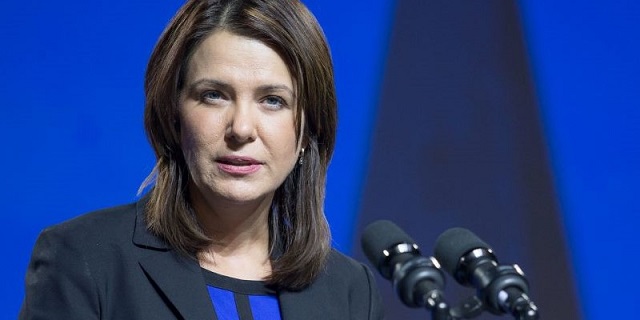Alberta
Don’t use Alberta’s Heritage Fund to pick ‘winners and losers’

From the Fraser Institute
During the mid- to late-1990s, Alberta taxpayers lost more than $2 billion from these failed loans, guarantees and share purchases in major business projects.
Remember the old adage from the writer and philosopher George Santayana that “those who cannot remember the past are condemned to repeat it.”
At a recent Calgary Chamber of Commerce event, Premier Danielle Smith indicated the Alberta government is looking at using Heritage Fund assets “to assist in de-risking projects that were finding it difficult to get financing.” This signals a return to the Alberta government’s industrial policy of the 1970s and 1980s of being in the business of being in business and government picking “winners and losers” as Premier Klein famously said.
A remembrance of the past is in order, so we aren’t condemned to repeat it. Between 1973 and 1992, the Alberta government took a very active role in cultivating economic development. The approach was highly interventionist and involved direct financial assistance through direct loans (even ones issued though the Heritage Fund), loan guarantees and share purchases. The risks attached to these transactions, particularly in a highly cyclical and volatile economy such as Alberta, were significant, generally unknown at the outset, and largely open-ended.
Sure, there were some notable exceptions, but the high degree of risk of direct intervention in the private sector was illustrated by the fact that during the mid- to late-1990s, Alberta taxpayers lost more than $2 billion from these failed loans, guarantees and share purchases in major business projects.
Most notable were losses incurred on such high-profile business projects as Novatel Communications ($556.0 million), the Lloydminster Bi-provincial Upgrader ($392.5 million), the Millar Western Pulp Mill ($244.2 million), Gainers ($208.3 million), the Magnesium Company of Canada ($164.0 million) and the Alberta-Pacific Pulp Mills ($155.0 million).
The premier makes a valid point that financial markets may be averse to financing large business projects because of the risks associated with intrusive federal climate change policies and regulations. Thus, the argument is there’s a need for the provincial government to get involved in financing market failures in the capital markets.
However, from our remembrance of the past practises, raiding the Heritage Fund to pick “winners and losers” is the wrong prescription to solving this problem. Let’s use the tried and true policies of cutting taxes and streamlining regulations to attract more investment capital to Alberta to support business projects. And let’s focus on building a Heritage Fund of $250 billion to $400 billion that will help secure our province’s fiscal and economic future and the future for our children and grandchildren.
Author:
Alberta
Alberta is investing up to $50 million into new technologies to help reduce oil sands mine water

Technology transforming tailings ponds
Alberta’s oil sands produce some of the most responsible energy in the world and have drastically reduced the amount of fresh water used per barrel. Yet, for decades, operators have been forced to store most of the water they use on site, leading to billions of litres now contained largely in tailings ponds.
Alberta is investing $50 million from the industry-funded TIER system to help develop new and improved technologies that make cleaning up oil sands mine water safer and more effective. Led by Emissions Reduction Alberta, the new Tailings Technology Challenge will help speed up work to safely reclaim the water in oil sands tailing ponds and eventually return the land for use by future generations.
“Alberta’s government is taking action by funding technologies that make treating oil sands water faster, effective and affordable. We look forward to seeing the innovative solutions that come out of this funding challenge, and once again demonstrate Alberta’s global reputation for sustainable energy development and environmental stewardship.”
“Tailings and mine water management remain among the most significant challenges facing Alberta’s energy sector. Through this challenge, we’re demonstrating our commitment to funding solutions that make water treatment and tailings remediation more affordable, scalable and effective.”
As in other mines, the oil sands processing creates leftover water called tailings that need to be properly managed. Recently, Alberta’s Oil Sands Mine Water Steering Committee brought together industry, academics and Indigenous leaders to identify the best path forward to safely address mine water and reclaim land.
This new funding competition will support both new and improved technologies to help oil sands companies minimize freshwater use, promote responsible ways to manage mine water and reclaim mine sites. Using technology for better on-site treatment will help improve safety, reduce future clean up costs and environmental risks, and speed up the process of safely addressing mine water and restoring sites so they are ready for future use.
“Innovation has always played an instrumental role in the oil sands and continues to be an area of focus. Oil sands companies are collaborating and investing to advance environmental technologies, including many focused on mine water and tailings management. We’re excited to see this initiative, as announced today, seeking to explore technology development in an area that’s important to all Albertans.”
Quick facts
- All mines produce tailings. In the oil sands, tailings describe a mixture of water, sand, clay and residual bitumen that are the byproduct of the oil extraction process.
- From 2013 to 2023, oil sands mine operations reduced the amount of fresh water used per barrel by 28 per cent. Recycled water use increased by 51 per cent over that same period.
- The Tailings Technology Challenge is open to oil sands operators and technology providers until Sept. 24.
- The Tailings Technology Challenge will invest in scale-up, pilot, demonstration and first-of-kind commercial technologies and solutions to reduce and manage fluid tailings and the treatment of oil sands mine water.
- Eligible technologies include both engineered and natural solutions that treat tailings to improve water quality and mine process water.
- Successful applicants can receive up to $15 million per project, with a minimum funding request of $1 million.
- Oil sands operators are responsible for site management and reclamation, while ongoing research continues to inform and refine best practices to support effective policy and regulatory outcomes.
Related information
Alberta
Alberta announces citizens will have to pay for their COVID shots

From LifeSite News
The government said that it has decided to stop ‘waste’ by not making the shots free starting this fall.
Beginning this fall, COVID shots in the province will have to be pre-ordered at the full price, about $110, to receive them. (This will roll out in four ‘phases’. In the first phases COVID shots will still be free for those with pre-existing medical conditions, people on social programs, and seniors.)
The UCP government in a press release late last week noted due to new “federal COVID-19 vaccine procurement” rules, which place provinces and territories as being responsible for purchasing the jabs for residents, it has decided to stop “waste” by not making the jab free anymore.
“Now that Alberta’s government is responsible for procuring vaccines, it’s important to better determine how many vaccines are needed to support efforts to minimize waste and control costs,” the government stated.
“This new approach will ensure Alberta’s government is able to better determine its overall COVID-19 vaccine needs in the coming years, preventing significant waste.”
The New Democratic Party (NDP) took issue with the move to stop giving out the COVID shots for free, claiming it was “cruel” and would place a “financial burden” on people wanting the shots.
NDP health critic Sarah Hoffman claimed the move by the UCP is health “privatization” and the government should promote the abortion-tainted shots instead.
The UCP said that in 2023-2024, about 54 percent of the COVID shots were wasted, with Health Minister Adriana LaGrange saying, “In previous years, we’ve seen significant vaccine wastage.”
“By shifting to a targeted approach and introducing pre-ordering, we aim to better align supply with demand – ensuring we remain fiscally responsible while continuing to protect those at highest risk,” she said.
The UCP government said that the COVID shots for the fall will be rolled out in four phases, with those deemed “high risk” getting it for free until then. However, residents who want the shots this fall “will be required to pay the full cost of the vaccine, the government says.”
The jabs will only be available through public health clinics, with pharmacies no longer giving them out.
The UCP also noted that is change in policy comes as a result of the Federal Drug Administration in the United States recommending the jabs be stopped for young children and pregnant women.
The opposite happened in Canada, with the nation’s National Advisory Committee on Immunization (NACI) continuing to say that pregnant women should still regularly get COVID shots as part of their regular vaccine schedule.
The change in COVID jab policy is no surprise given Smith’s opposition to mandatory shots.
As reported by LifeSiteNews, early this year, Smith’s UCP government said it would consider halting COVID vaccines for healthy children.
Smith’s reasoning was in response to the Alberta COVID-19 Pandemic Data Review Task Force’s “COVID Pandemic Response” 269-page final report. The report was commissioned by Smith last year, giving the task force a sweeping mandate to investigate her predecessor’s COVID-era mandates and policies.
The task force’s final report recommended halting “the use of COVID-19 vaccines without full disclosure of their potential risks” as well as outright ending their use “for healthy children and teenagers as other jurisdictions have done,” mentioning countries like “Denmark, Sweden, Norway, Finland, and the U.K.”
The mRNA shots have also been linked to a multitude of negative and often severe side effects in children and all have connections to cell lines derived from aborted babies.
Many Canadian doctors who spoke out against COVID mandates and the experimental mRNA injections were censured by their medical boards.
LifeSiteNews has published an extensive amount of research on the dangers of the experimental COVID mRNA jabs that include heart damage and blood clots.
-

 Alberta2 days ago
Alberta2 days agoAlberta’s grand bargain with Canada includes a new pipeline to Prince Rupert
-

 Bruce Dowbiggin1 day ago
Bruce Dowbiggin1 day agoWOKE NBA Stars Seems Natural For CDN Advertisers. Why Won’t They Bite?
-

 Business2 days ago
Business2 days agoCarney’s European pivot could quietly reshape Canada’s sovereignty
-

 Health21 hours ago
Health21 hours agoLast day and last chance to win this dream home! Support the 2025 Red Deer Hospital Lottery before midnight!
-

 Crime12 hours ago
Crime12 hours agoUK finally admits clear evidence linking Pakistanis and child grooming gangs
-

 Business16 hours ago
Business16 hours agoCarney praises Trump’s world ‘leadership’ at G7 meeting in Canada
-

 Energy1 day ago
Energy1 day agoCould the G7 Summit in Alberta be a historic moment for Canadian energy?
-

 Crime1 day ago
Crime1 day agoMinnesota shooter arrested after 48-hour manhunt



